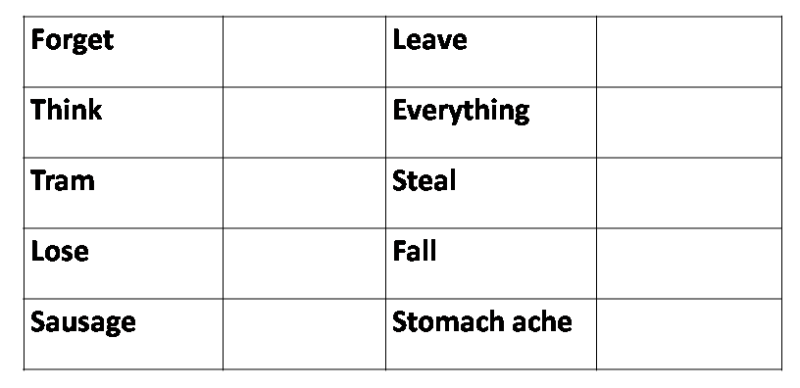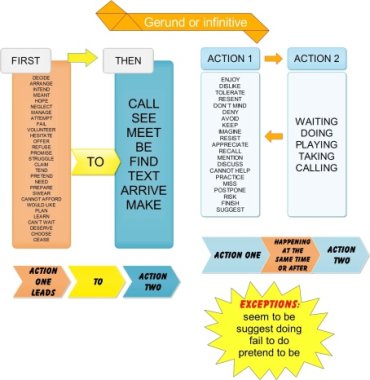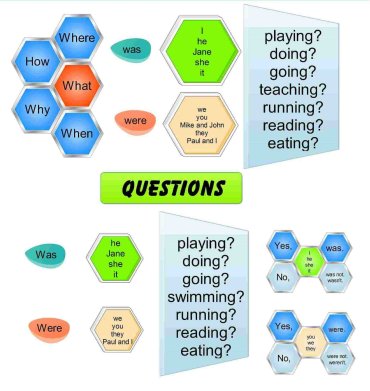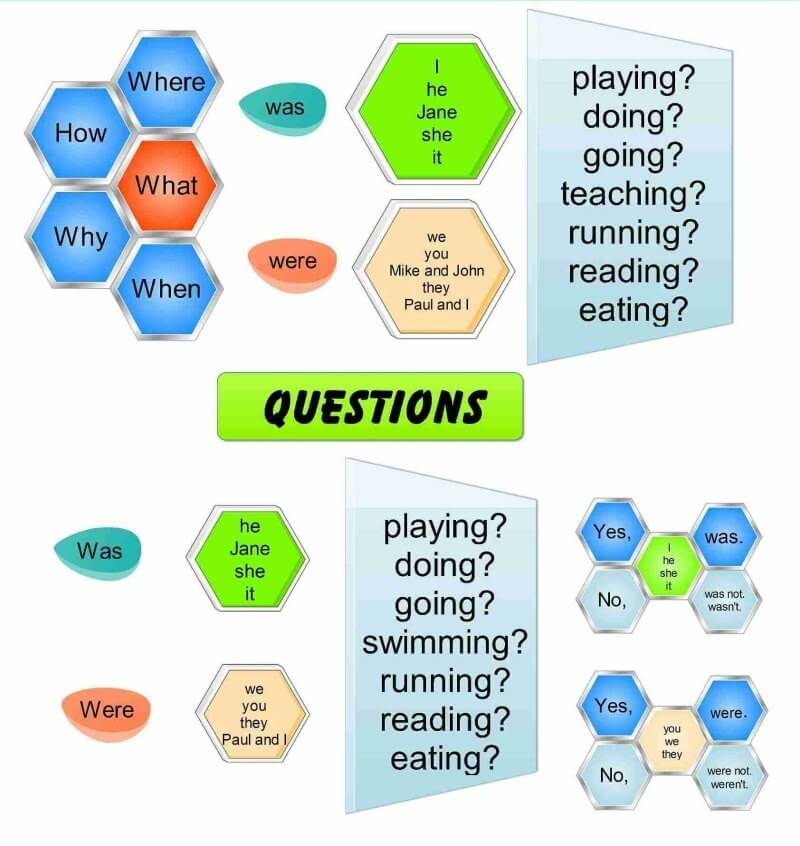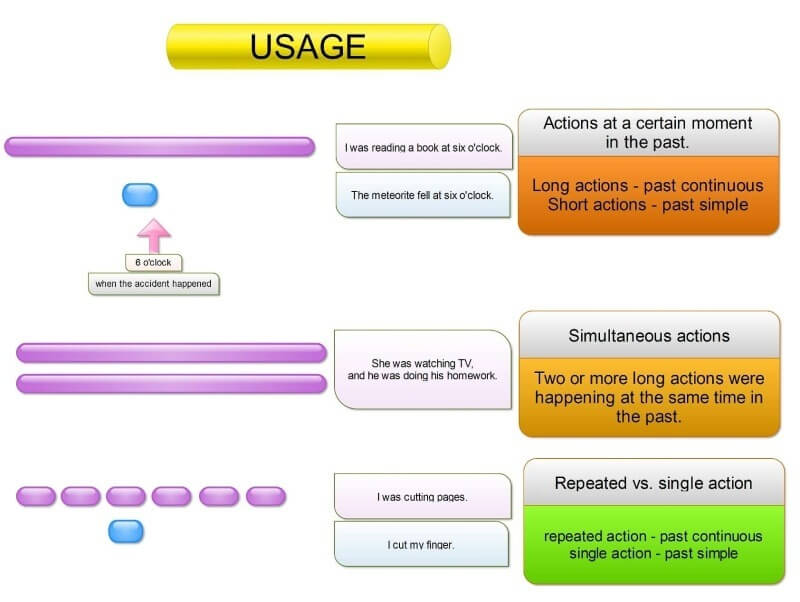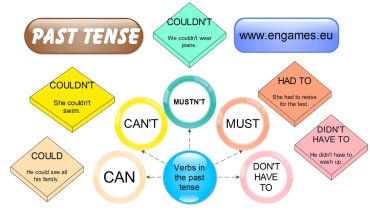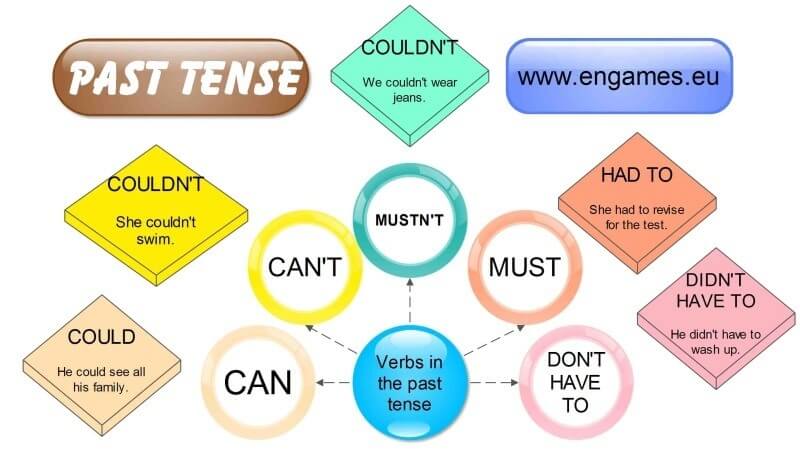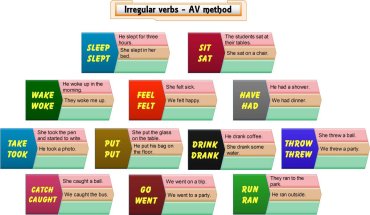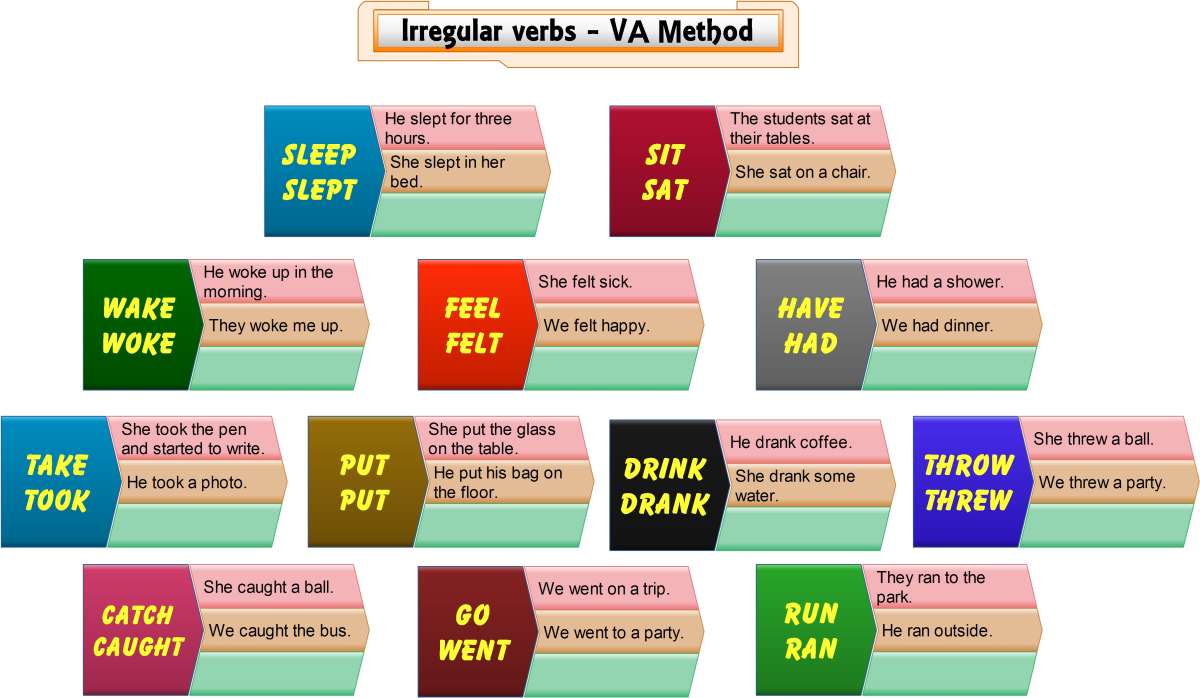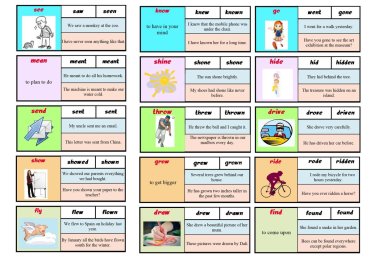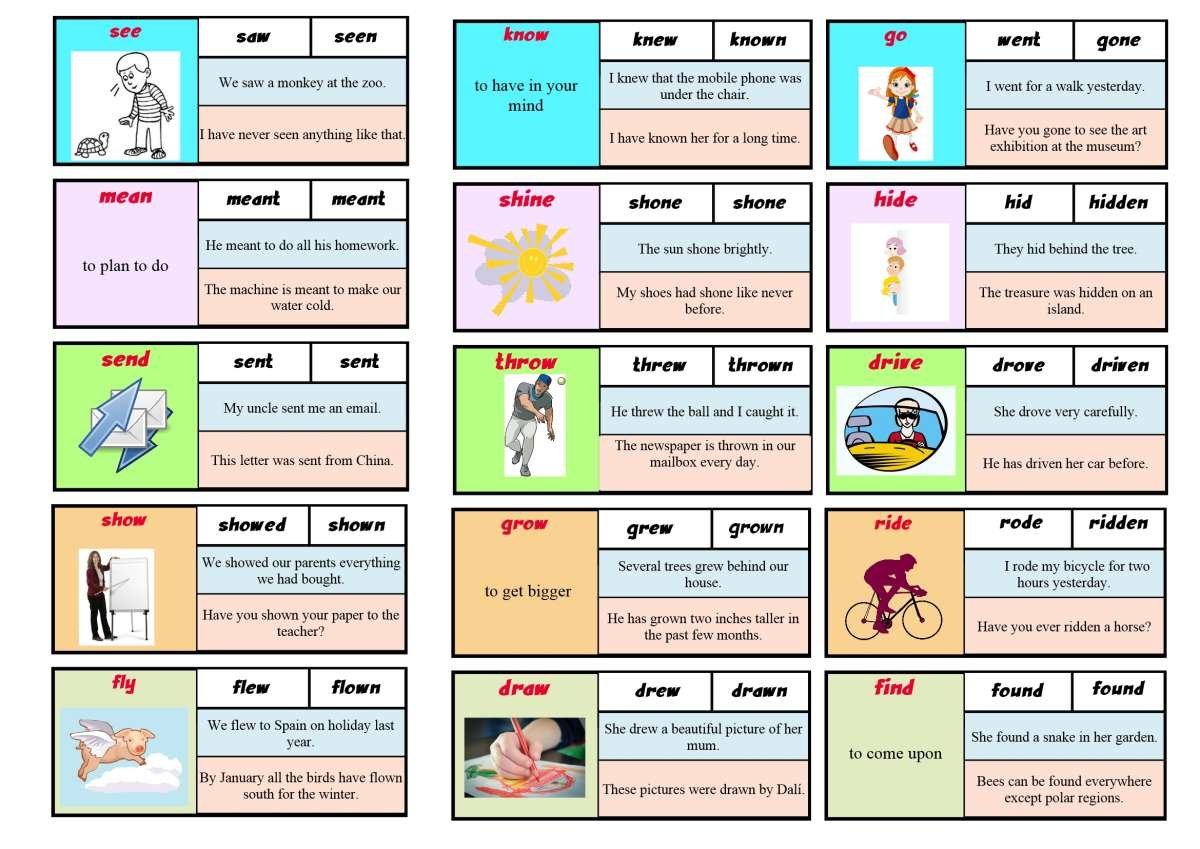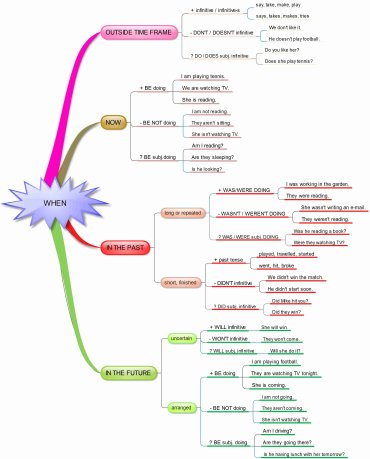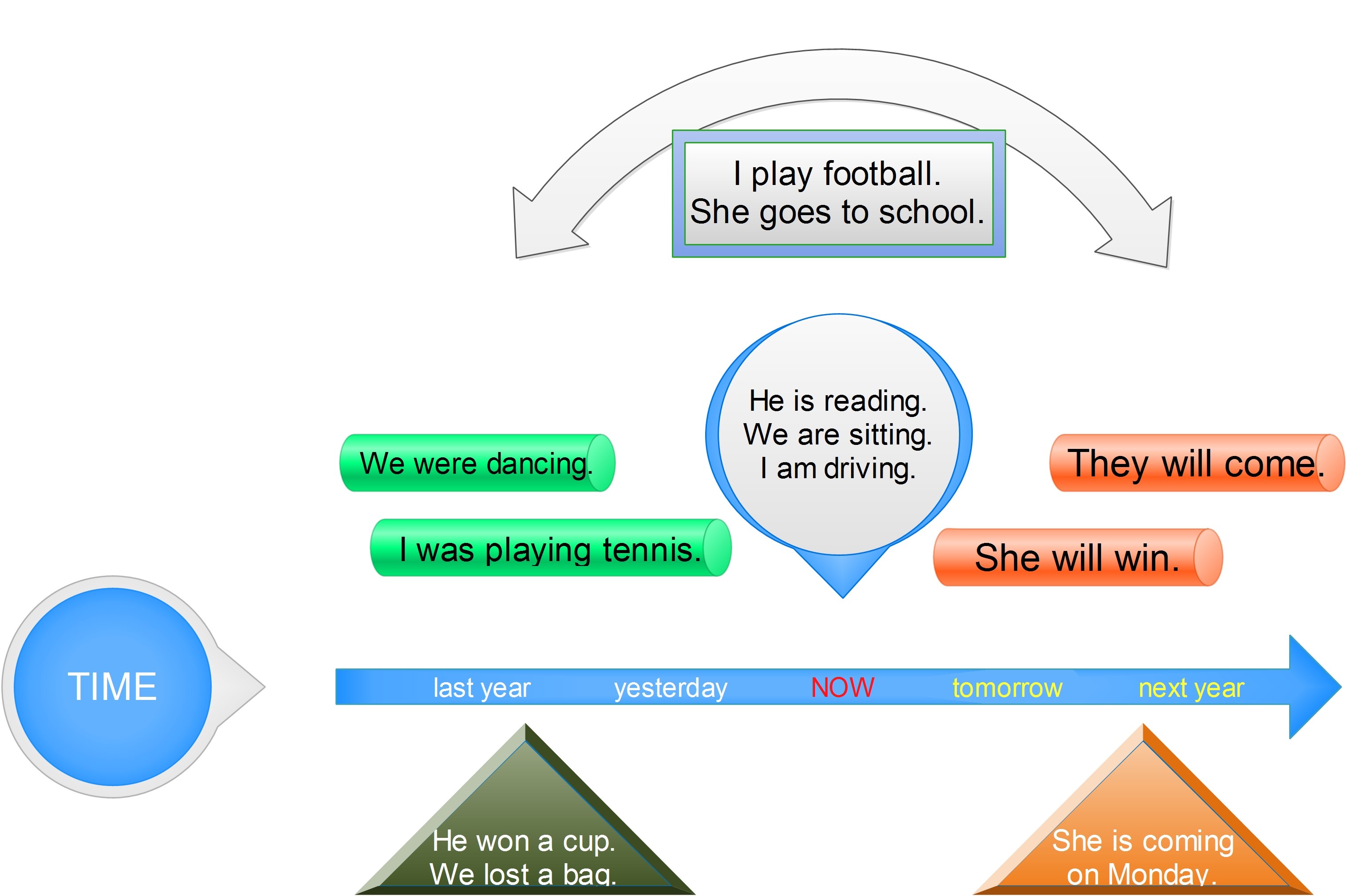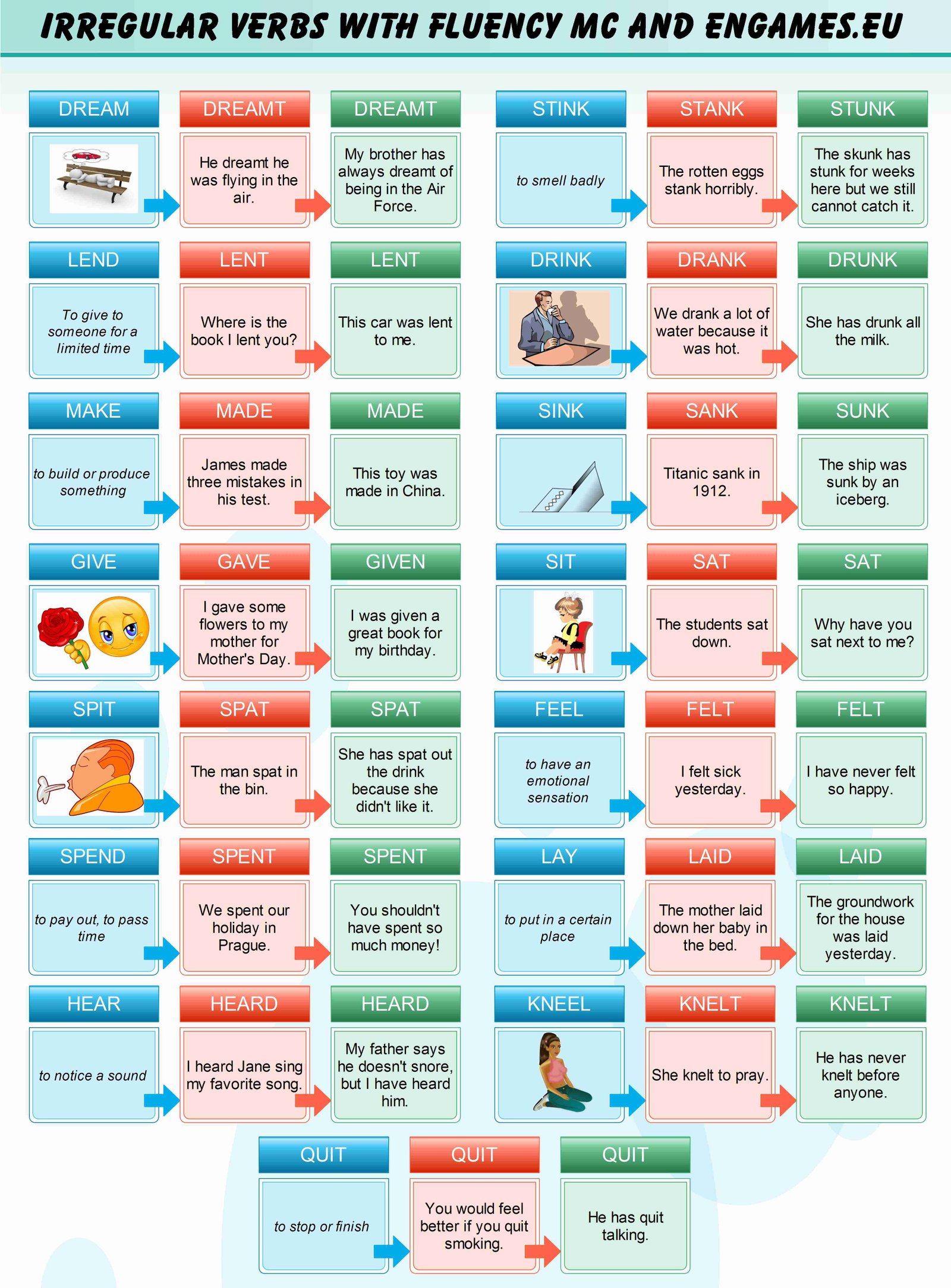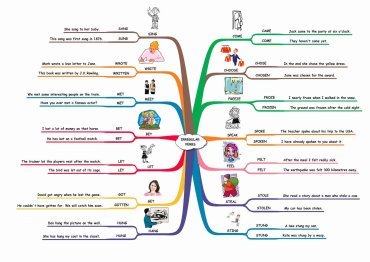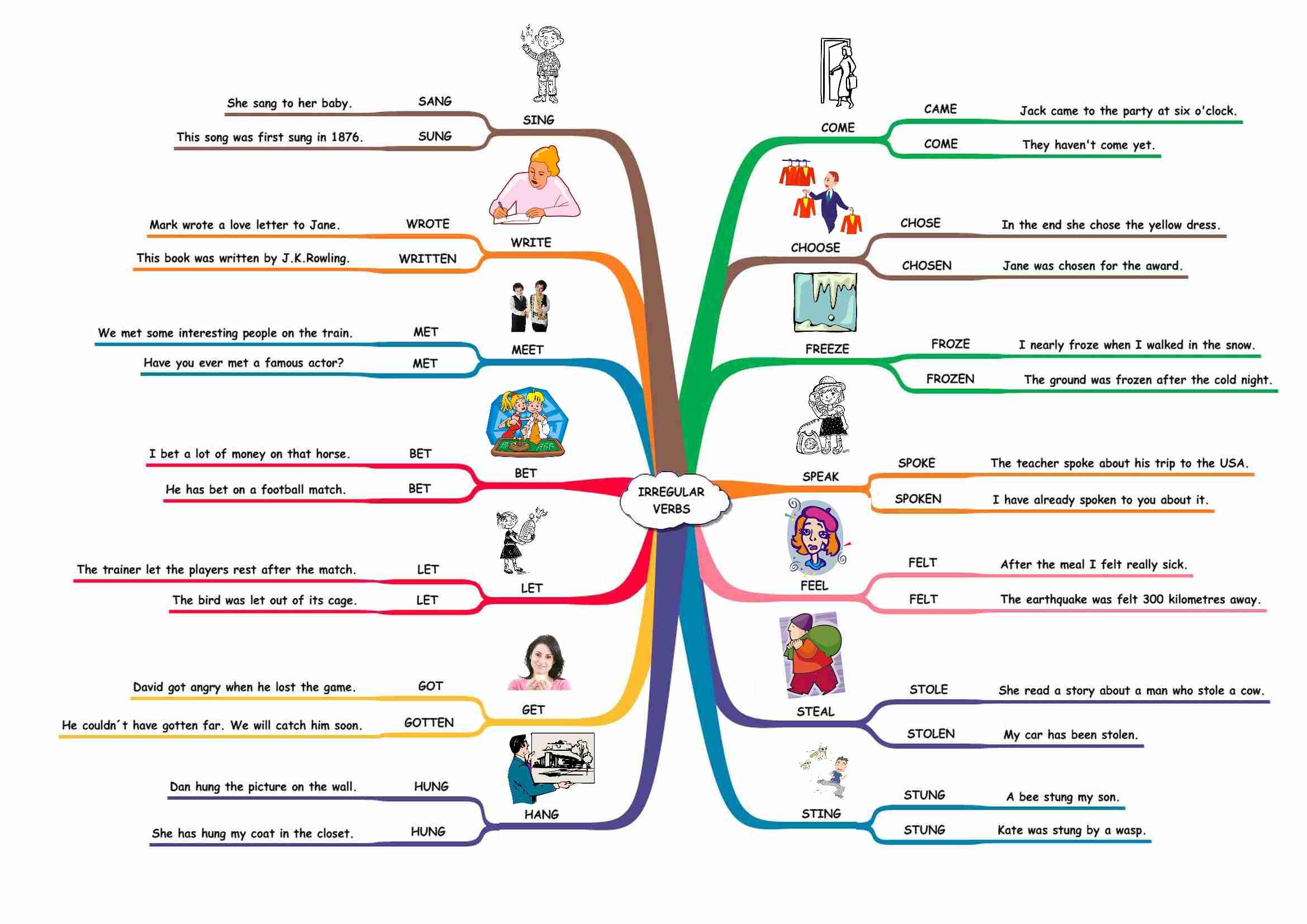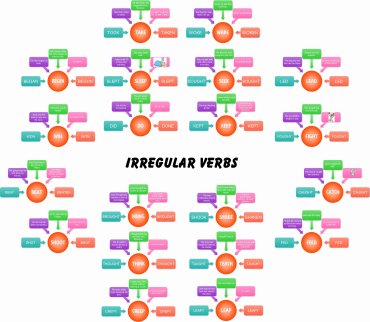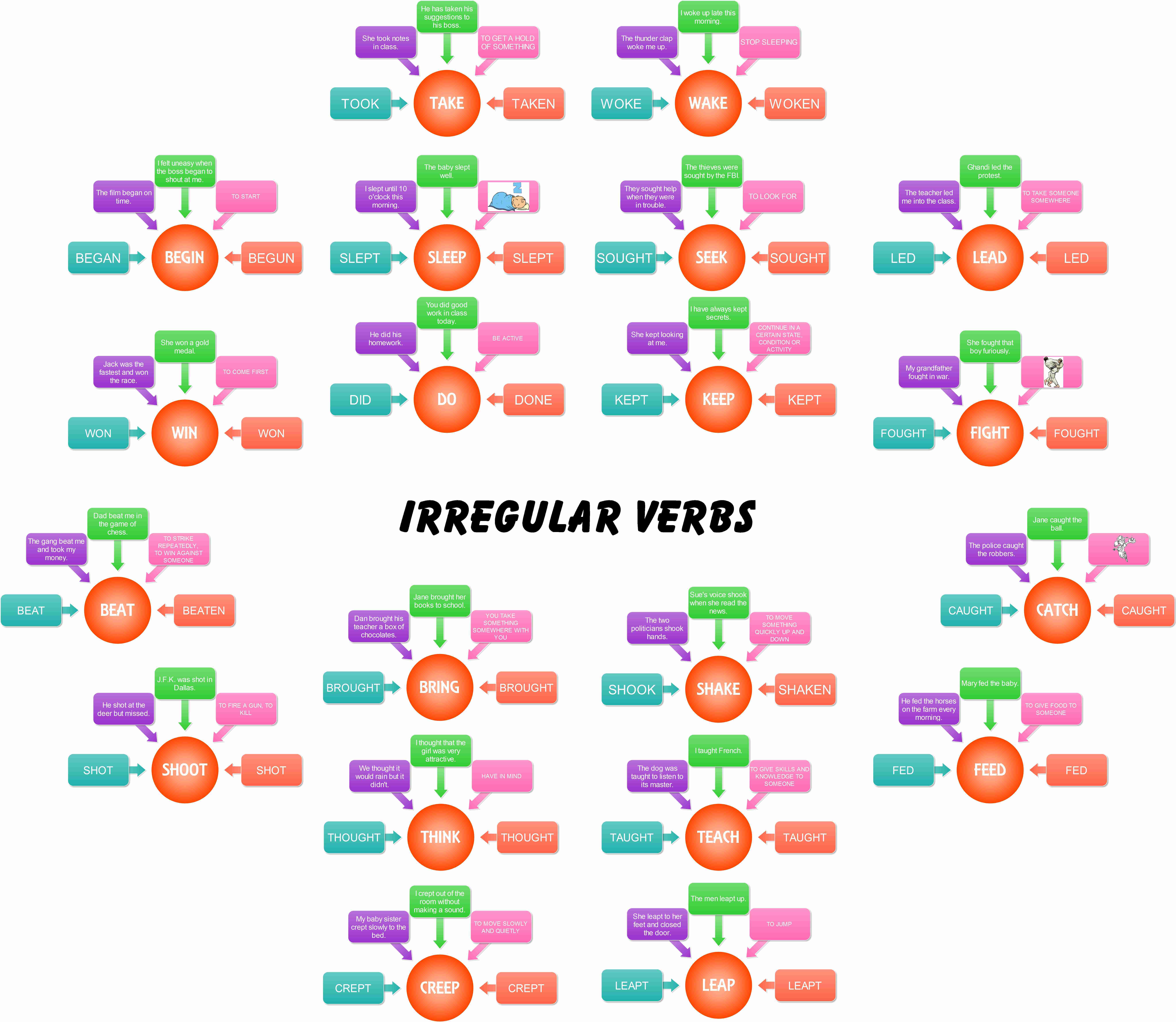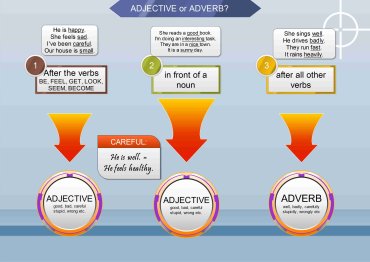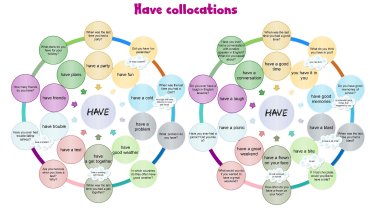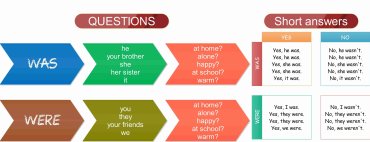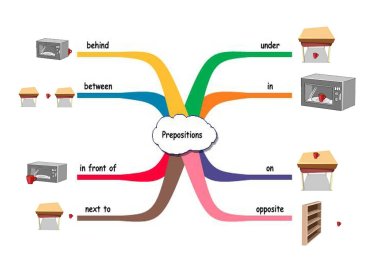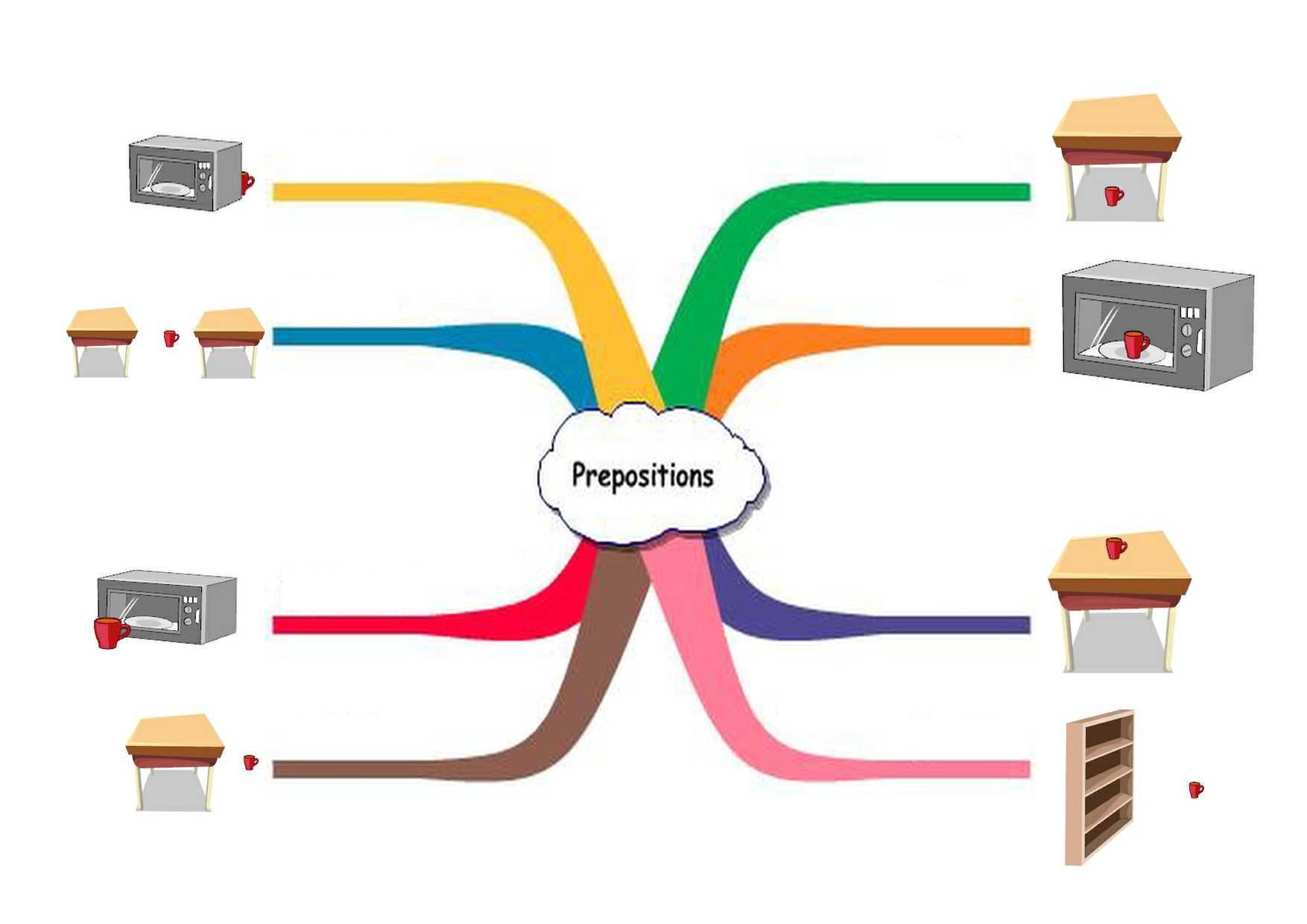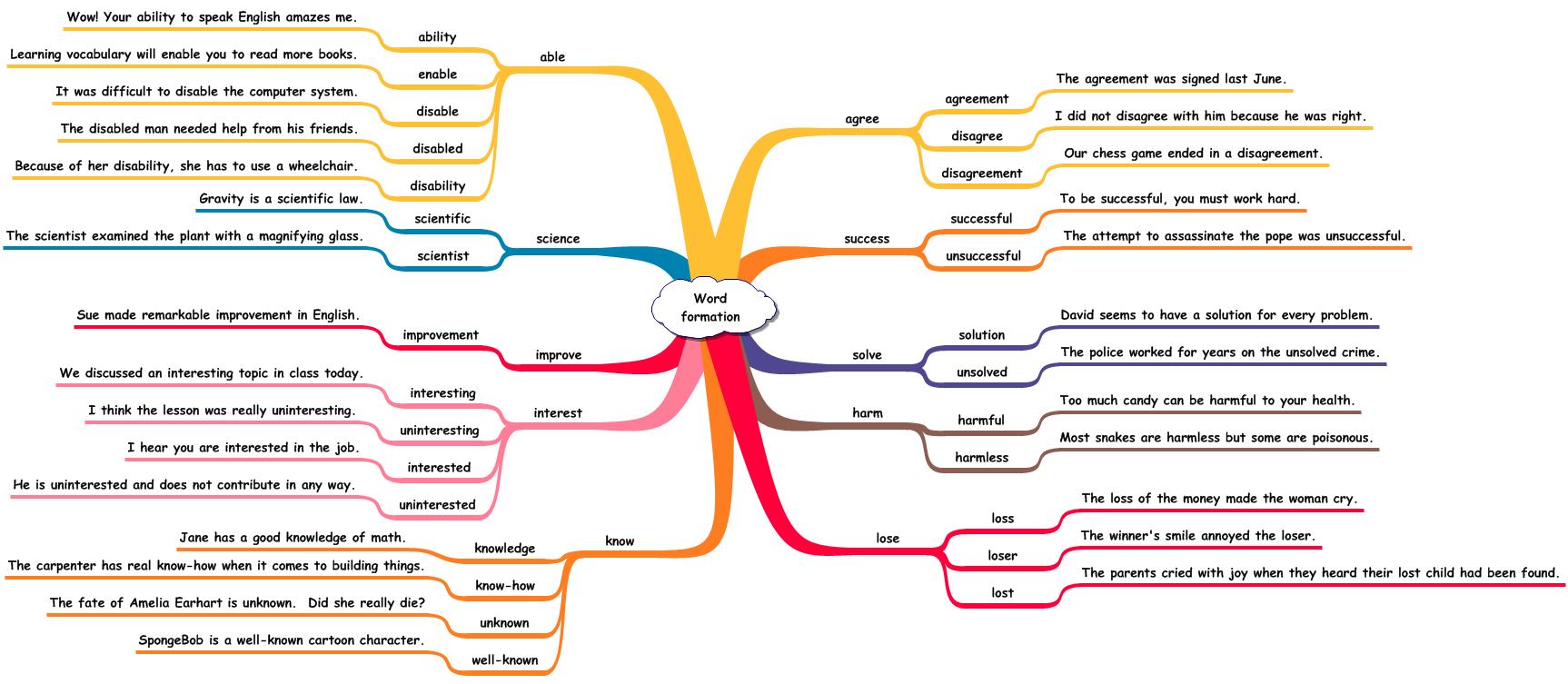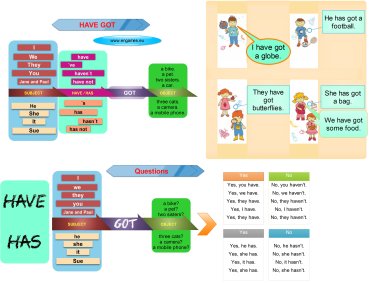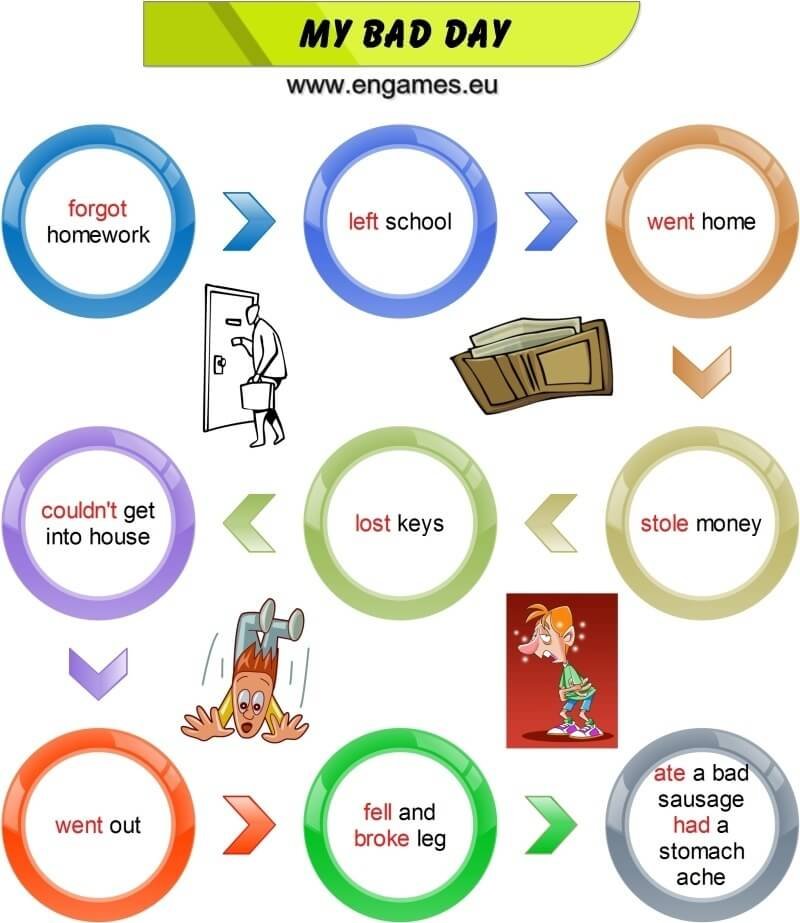 In this post, I offer a set of activities for teaching 9 English irregular verbs. I have tested the sequence in class several times, and I have tried to improve it to get even better results. Right now I feel that the following sequence will ensure that students will learn the past tense of at least seven of these verbs.
In this post, I offer a set of activities for teaching 9 English irregular verbs. I have tested the sequence in class several times, and I have tried to improve it to get even better results. Right now I feel that the following sequence will ensure that students will learn the past tense of at least seven of these verbs.
ADVERT:
[showmyads]
The sequence contains the following steps: a vocabulary activity, reading and comprehension questions, a listening drill, a Grammar Up activity, a crossword, a wordsearch, a word order activity and a speaking exercise.
Let’s start.
English irregular verbs – vocabulary
English irregular verbs – reading
Read the text and put the actions into the order in which they happened:
Yesterday was a bad day. First I forgot to do my homework and my teacher was angry. I left school at 2 o´clock and I thought that everything was OK. I went home by tram and someone stole my money. Then I lost my keys and I couldn´t get into my house. So I went out, but I fell and broke my leg. In the evening I ate a bad sausage and then I had a stomach ache. It was a really bad day.
Put the actions into the correct order
go out
have stomach ache
forget homework
leave school
lose keys
eat a bad sausage
someone steals his money
teacher be angry
cannot get into house
break leg
fall
go home
English irregular verbs – Listening drill
English irregular verbs – Grammar Up
Yesterday BE * bad day. First I FORGET – do my homework and my teacher BE angry. I LEAVE school – 2 o´clock and I THINK that everything BE OK. I GO home – tram and someone STEAL my money. Then I LOSE my keys and I CANNOT get into my house. So I GO out, but I FALL and BREAK my leg. – * evening I EAT * bad sausage and then I HAVE * stomach ache. It BE * really bad day.
English irregular verbs – crossword
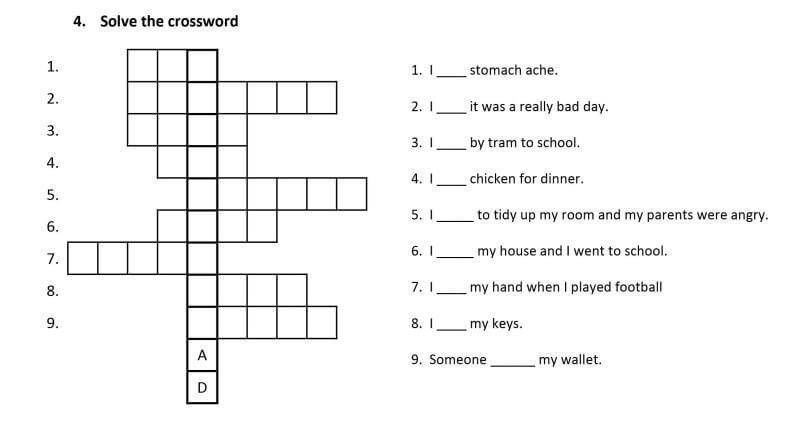
English irregular verbs – word order

English irregular verbs – wordsearch
ADVERT:
[showmyadsa]
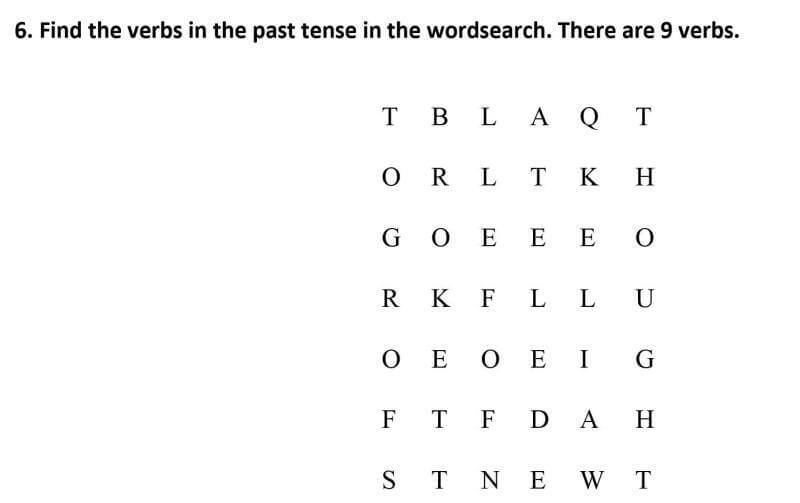
English irregular verbs – speaking
7. Retell the story. Use the clues below:
Forget homework
leave school
go home
steal money
lose keys
cannot get into my house
go out
fall
break leg
eat sausage
have stomach ache
If you would like to have all the activities in one worksheet, you can download the pdf worksheet here.
English irregular verbs in context
By now students should be able to remember the nine irregular verbs from this story. If you have time you should play the video again and ask your students to repeat the sentences. I believe that a good way to consolidate your students’ the knowledge of the English irregular verbs is to play the video once per class for a number of classes.
Engames and Fluency MC have joined forces again to bring you a post that will help you decide whether you should use a gerund or an infinitive after a verb. This post is not going to provide a comprehensive overview of the grammar. Our aim is to give your students a simple guide to help them decide correctly between the two parts of speech most of the time.
ADVERT:
[showmyads]
The post contains a song, an infographic, an interactive online quiz and a game.
Gerund or Infinitive – pretest
Do you think you know the grammar already and don´t need to read the article? Try the following test and see how well you do. [viralQuiz id=1]
[showmyads]
Gerund or Infinitive – song
Watch the following song and complete the lyrics. The aim of this song is to introduce the topic.
Here are the lyrics in a pdf file:
Lyrics gerund
Here are the lyrics as supplied and created by Fluency MC:
Gerund-or-Infinitive
Gerund and Infinitive – infographic
The following infographic does not contain a comprehensive list of all the verbs. Only the verbs that are used in the song appear here.
These rules are so called rules of thumb. They work in most cases but not all. However, to use the rules correctly, students first have to understand them.
The rule goes like this: “If the first verb happens before the second verb, use TO. If the second verb happens at the same time or before the first verb use the ending -ING with the second verb. “ Thus in the sentence “I hope to go to the party,” I first hope and then go to the party. That is why you use TO. On the other hand, in the sentence “I enjoyed going to the party,” I enjoyed the party at the same time as I was there.
Assess your students understanding of the rules using the following test. Choose 10 verbs at random and ask your students to write them down and write if they think they should be followed by TO or -ING. Then go through their responses and elicit the correct answers.
Once you feel that the students know the grammar, it is time to practise it.
Gerund or infinitive – online quiz
The best way to remember the verb patterns is by using them. The following quiz is in HTML5 and will work on all mobile devices.
ADVERT:
[showmyadsa]
To display the quiz on full screen click the button below.
Gerund or infinitive? – quiz
The second game is in Flash and will play only on desktop computers. It is called On Target, and your task is to choose the correct option and then shoot all the bad cows and ducks. You can shoot one of the bottles on the wall to get a bonus. Enjoy.
Gerund or infinitive – On target game
Gerund or infinitive – links
At engames.eu I have already published two posts on the use of gerunds and infinitives in English. The first post is called Verb Patterns – preintermediate, and the second is called Verb Patterns again – final solution. You can practise the grammar there as well.
Yesterday a friend sent me a song he’d written that uses only the past simple and past continuous tenses. He asked me how I liked it, and I had to admit it was great. A few hours later I encountered a short explanation of the same grammar by Australiaplus.com, and I realised that I wanted to share both with my friends on the Internet. This post is the result.
ADVERT:
[showmyads]
In this post there is the song by Chris Barickman, a video explanation, an explanation by Australiaplus.com, an infographic and an interactive quiz.
Past simple and continuous – song
Let’s start with the song. Please listen and complete the lyrics:
The lyrics worksheet:
Past continuous tense lyrics
Past simple and continuous – explanation
Now listen to the following explanation.
And here is another short explanation of the same grammar by Australiaplus.com:
https://soundcloud.com/australiaplus/past-continuous
Past simple and continuous – infographic
Here is a set of infographics created by www.engames.eu.
If you want to download the full infographic in superb quality, you can do that here:
Past continuous tense – full infographic
Past simple and continuous – quiz
The following quiz is in HTML 5 so it will play on all mobile devices and desktop computers. Your task is to choose the correct tense – either the past simple or the past continuous. Enjoy the games if you pass the tests.
The past tenses of the modal verbs MUST, CAN and CAN’T often cause problems, even for advanced students of English. I have heard some of my best students, who had already passed the CAE exam, use words like MUSTED, and I was not happy about it. That is why I try to teach this grammar thoroughly.
ADVERT:
[showmyads]
In this post I would like to share an infographic and additional exercises I use to teach this grammar point. I hope you find this post useful. Please don’t hesitate to share any of your materials on this topic. You can send them to my email: rotreklzdenek @gmail.com. Thank you.
Modals in the past tense – infographic
Display the following infographic to your students and explain that MUST does not have a past tense. Instead, they should use the past tense of HAVE TO. Go through all the verbs and elicit their meaning. Then ask your students to work in pairs. One of them will turn with their back to the screen, and the other will say the verb in the present tense. The student whose back is turned then has to say the verb in the past tense. It is a kind of drill, but if you ask your students to do this for one minute each, it is very effective.
Modal verbs in the past tense – quiz
The following quiz is in HTML 5 so it will work on all mobile devices and desktop computers. Students can do the quiz either at home or at school in a computer lab. If they complete each of the texts with the correct modal verb in the past tense they will be rewarded with a game.
Modal verbs in the past tense quiz
Modal verbs in the past tense – links
There are some very interesting exercises at the British Council site.
There are more exercises on this topic at the BBC learning English site.
Category: English games, Grammar, Intermediate
In my opinion, vocabulary is the most important part of language learning. If you know some words and no grammar, you can communicate. However, if you know a lot of grammar and no words, communication is impossible.
ADVERT:
[showmyads]
In this post I would like to give you a chance to enrich your students vocabulary with words for describing items of clothing. There is an infographic, a film and an online quiz to help you teach over 30 words connected with clothing. I hope you find this post useful.
Clothes vocabulary – film
Here is a film to present and teach vocabulary connected with clothes. All the words are displayed, and pronounced by a native speaker. The video consists of two parts. In the first part the students see the clothes, and the word and they hear the native speaker pronounce the word. Their task is to repeat the words. In the second part of the video they only see the clothes, and their task is to say the correct word before they hear the speaker.
Clothes vocabulary – infographic
To make sure that your students can practise the vocabulary at home too, print out the following infographic and hand it out.
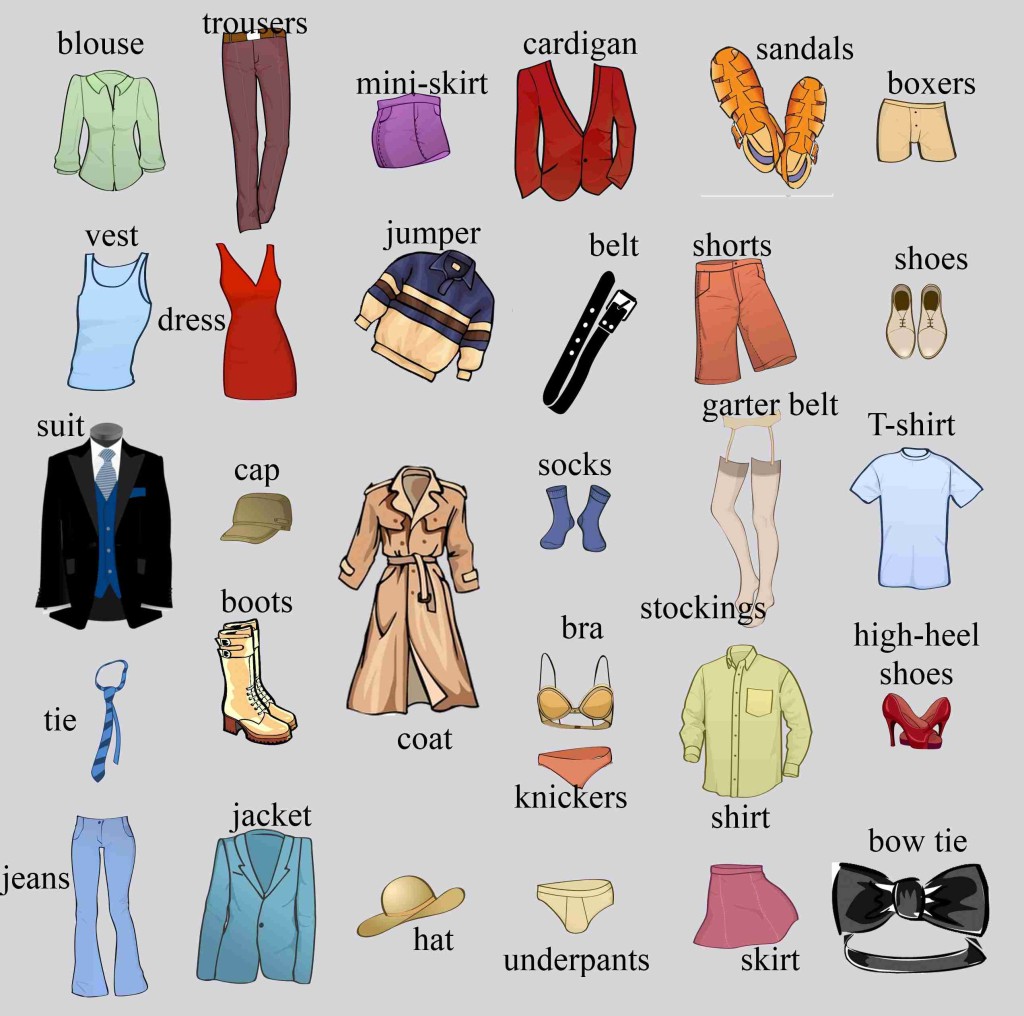
Clothes vocabulary – online quiz
The following quiz is in HTML5 and will play on all mobile devices. It consists of two parts. In the first part, you should match the words with the correct pictures and then click on the correct piece of clothing.
In the second part of the quiz, you have to write the words you see in the picture. If you pass any of these parts, you will be rewarded with a game.
ADVERT:
[showmyadsa]
Clothes vocabulary – quiz
Clothes vocabulary – Links
You can find some great materials to teach clothes vocabulary at the British Council site.
Facebook is the most popular social network in the world. Many of our students spend hours on it every day. But have you ever given them a chance to speak about Facebook in an English lesson?
In this post I would like to bridge this gap and give you a chance to teach some words connected with Facebook. Once the students know the words they will be able to talk about Facebook and what they do there. To teach the vocabulary, there is an infographic, a quiz and several speaking activities.
ADVERT:
[showmyads]
Facebook vocabulary – infographic
Go through the following infographic with your students and ask them to translate the words if you teach a monolingual group.
Facebook vocabulary – online quiz
In the following quiz your students can practise the vocabulary taught in the infographic. The quiz consists of two parts. It is in HTML5 and it will play on mobile devices and desktop computers.
Facebook vocabulary – speaking
The following section contains several speaking activities to give your students a chance to practise the new words in a meaningful way.
The first activity works very well with students who are 15 or older. Hand out the following questions and ask your students to choose three questions they would like to ask you.
a) What was the last post you put on your timeline?
b) Do you share your photos on Facebook?
c) What was your last comment?
d) How often do you comment?
e) How often do you write a status on your timeline?
f) What was the last post you liked?
g) How many friends do you have on Facebook? Do you know your friends personally?
h) Do you ever message anyone? How often and why?
i) What is in your cover photo?
j) What was the last thing you shared on Facebook? How often do you share things?
k) Do you use news feed or any apps on Facebook?
l) Are you a member of any groups? Why?
Answer the questions as best as you can and demonstrate the way you would like your students to discuss the questions.
Then ask your students to choose 7 questions they would like to ask their partner. Ask them to work in pairs and discuss the questions.
ADVERT:
[showmyads]
The second speaking activity is called ranking. The students should rank the following Facebook features from the most useful and interesting to the least.
GROUPS, BOOST POST, STATUS, MESSAGE, COVER PHOTO, LIKE, SHARE, PROFILE, COMMENT, EVENT
If you have never done a ranking activity with your students before, it is a good idea to teach the phrases first. Teach phrases like: “I think …. is the most useful…,” “I think …. is the least useful …,” etc. If your students are not able to use these phrases, their discussion will not be very interesting or long.
Recently I have published 4 posts on teaching irregular verbs. The posts were based on a rap song by Fluency MC. This post is different.
This time I am introducing a new method of teaching the past tense of irregular verbs. The method is called the Visual-Audio Method, and I think it is completely new. I have managed to try it out with only with one class so far, but I can say that it worked.
ADVERT:
[showmyads]
Irregular verbs – video
Here is the video for the Visual-Audio Method. It consists of three parts. In the first part the students listen to, read and repeat the sentences. In the second part they listen to the sentences and repeat them, but the words don’t appear on screen. In the third part they see the picture of the action and they have to supply the sentence before they hear it.
You should play the video at least once in each lesson for one or two weeks to ensure that the students remember the phrases.
Irregular verbs – infographic
The following infographic should help the students revise the words. You can ask your students to translate the phrases.
Irregular verbs – quizzes
Your students can test their knowledge of the past tense of the verbs in the following HTML5 quiz. The quiz will play on all mobile devices and desktop computers.
Irregular verbs Quiz
The following two games are in Flash and will play only on desktop computers. They are really fun. I often play them with my classes at school.
ADVERT:
[showmyadsa]
Irregular verbs Half a minute
This is the last post in which we try to teach the irregular verbs mentioned in the rap song by Fluency MC. This time there are 15 irregular verbs and to help you teach or learn them there is an infographic, a quiz and a game.
Irregular verbs – song
First, listen to the following song and complete the lyrics. Start at 2:45.
ADVERT:
[showmyads]
The lyrics worksheet:
Irregular verbs song lyrics 4
Irregular verbs – infographic
Display or hand out the following infographic and go through the irregular verbs with your students. Explain the meaning of the more difficult verbs if necessary or ask your students to use dictionaries.
To print ot the infographic, use the following pdf file:
Irregular verbs with fluency 04
Irregular verbs – online quiz
The following online quiz consists of two parts. In the first part the students should match the irregular verbs and their meanings, and then complete the sentences with an appropriate irregular verb in the past tense.
In the second part the students should drag the irregular verbs to the appropriate spaces in the sentences. After they pass each part of the quiz they will be rewarded with a game.
The quiz is created in HTML5, so it will play on all electronic devices and computers. Irregular verbs Quiz
The second game is called Goose Science Quiz, and your task is to click the dice in the upper right hand corner and then answer the questions. If you manage to get to the finish first, you will win the game. The game can be played by multiple people at the same time.
Once again, the game is in HTML5, so it will play on all electronic devices and computers.
Irregular verbs – all irregular verbs with Fluency MC posts
As I wrote above, this is the fourth post we have prepared together with Fluency MC. You can find the previous posts here:
ADVERT:
[showmyadsa]
Students often learn just one piece of grammar in a lesson. Most of them master that day’s subject and move on to the next. But, when the time for revision comes, they often don’t remember what they’ve learnt.
For example, two weeks ago my class encountered an exercise in which several tenses were revised. First, they demanded that I re-explain the grammar and then they seemed really confused about what form they should use.
ADVERT:
[showmyads]
That was why I decided to stop there and prepare several exercises and a clear mind map. You can find them here.
Six tenses – infographic
There are two different mind maps in this post. The first one shows when different tenses should be used. If you decide to use this mind map, you will have to explain the grammar yourselves.
The second infographic is much more detailed. You will have to explain this one to your students as well. You have to emphasize that they first have to ask when the action happens. Does it happen NOW, IN THE FUTURE, IN THE PAST or ALL THE TIME? Once they answer that question, they should follow the appropriate branch. If the action happens in the past, they have to decide if the action was a long one or a short one and then use the appropriate tense.
If the action happens in the future, they have to decide how certain the action is and then use the appropriate form. Promises and predictions are considered uncertain.
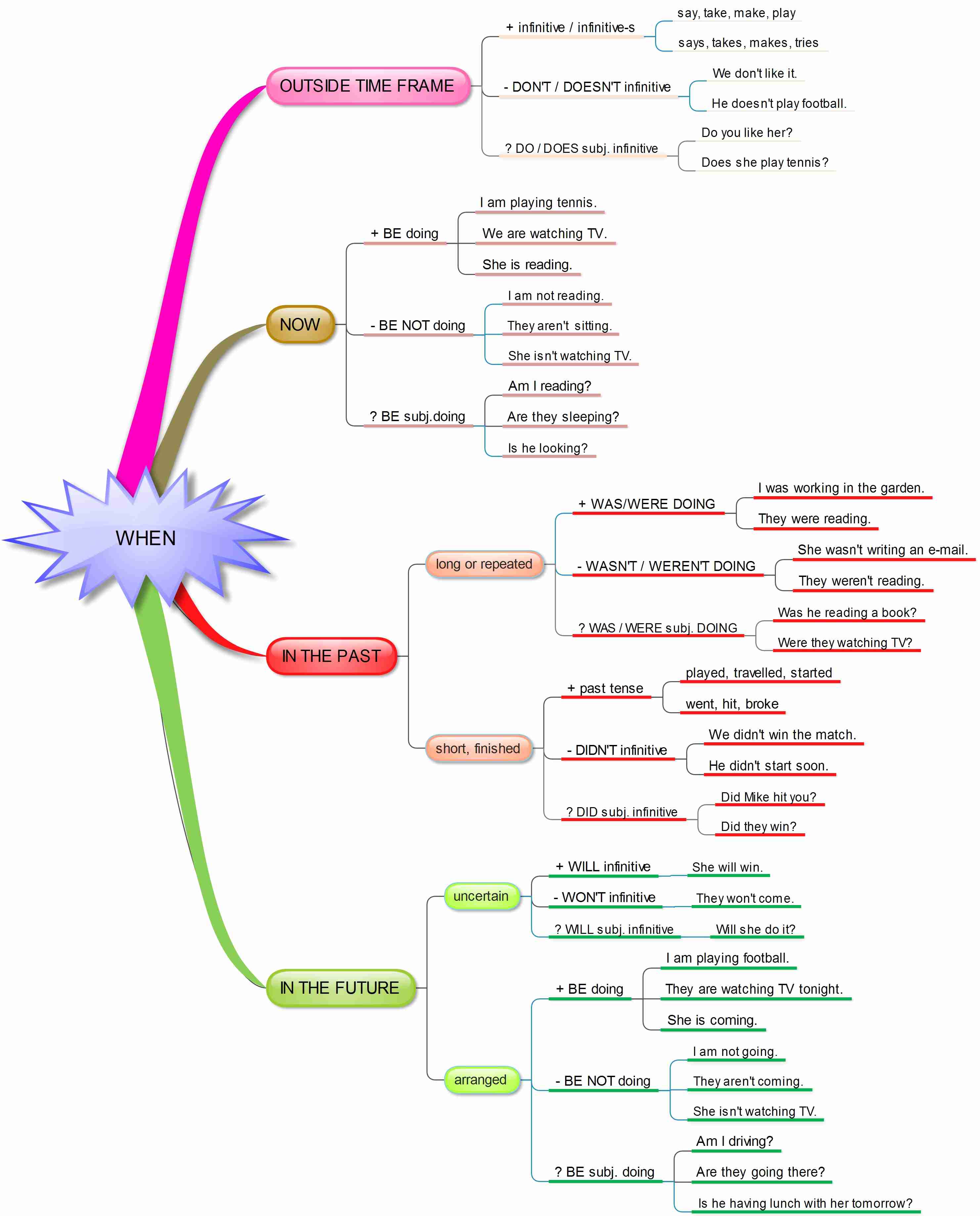
Six tenses – online quiz
Now that your students understand the grammar, they have to use it as soon as possible. Allow them to use the infographic here.
The following online quiz is in HTML5, so your students can try it out on their mobile phones while you do it on the interactive whiteboard. The quiz has two parts. You will get to play a game after each part if you pass.
If you cannot do the exercise online, you can try the following paper version of the quiz.
More exercises
You can find more exercises to practise different tenses at Five Tenses and Five Tenses additional exercises.
As I wrote before, irregular verbs are the most important thing for all students of English to learn. However, it is not easy to master them. That is why Fluency and I started to collaborate on a series of posts that deal with teaching just the irregular verbs.
ADVERT:
[showmyads]
In this post we are going to introduce another set of 15 verbs. To learn them there is a song, an infographic, a quiz and a game. If you go through all the activities you will meet each word at least 6 times. We hope you will like our work and share the post.
Irregular verbs – song
Listen to the following song and try to complete the lyrics. To complete the lyrics start the song at 2:05.
You can find the lyrics here:
Lyrics part 3
Irregular verbs – infographic
Here is the infographic with all the irregular verbs, you should learn in this post. For each word there is a definition (in either word or picture form) and two examples of usage.
Display the infographic and go through the verbs with your students. Explain the meaning of the difficult words.
Irregular verbs – game and quiz
Here is a two-part online quiz. Your task is to choose the correct answers and pass the quiz. You you will be rewarded with a game after each part of the quiz if you pass.
This game is in HTML5, so it will play on all mobile devices as well as desktop computers.
Irregular verbs – other sites
You can find more irregular verbs practise at https://grammarlane.com/irrverbs/irrverbsen.html . Choose the irregular verbs you want to practise and choose the mode (speaking or writing). Then write or say the past tense and the past participle of the verbs you see.
Irregular verbs by British Council.
ADVERT:
[showmyadsa]
A song by Fluency MC on irregular verbs:
In my opinion, irregular verbs are the most important thing one has to learn in English. Therefore, it is absolutely essential that students know them. However, teaching them is not easy. There are no rules, and the number of new words that students manage to commit to memory is quite low. Thus the teaching materials have to be interesting enough that students would return to them.
And one of the best materials for teaching irregular verbs is this song, which was created by Jason R Levine from Fluency MC:
ADVERT:
[showmyads]
In this post we are going to deal with the verbs mentioned in the second verse of the song. Below you will find an infographic, an online quiz and a game to help your students learn the irregular verbs.
Irregular verbs – infographic
Display the following infographic and go through the words with them. Use the pictures to explain the meaning or ask your students to use their dictionaries.
Rate this picture:
[wp-review]
Irregular verbs – an online quiz and a game
Start with the online quiz. The quiz is in HTML5 so it will play on mobile devices too. In the first part, you should drag the words to the correct spaces. If you pass, you will be rewarded with a game called Angry Farmer. In the second part, you have to look at the picture and complete the sentence. Use the past tense of a verb that best fits the sentence. Irregular verbs quiz
Irregular verbs – links
You can practise the irregular verbs in sentences in the following video.
Irregular verbs by British Council.
ADVERT:
[showmyadsa]
A song by Fluency MC on irregular verbs:
I have already published 10 posts on teaching irregular verbs. You can see the list of the posts down here:
- Irregular verbs again
- Irregular verbs again 2
- Irregular verbs – third time lucky?
- Irregular verbs in context 1
- Irregular verbs straightforward
ADVERT:
[showmyads]
- Irregular verbs straightforward #2
- Irregular verbs straightforward #3
- Teach 9 irregular verbs in one lesson
- Irregular verbs in context – Scream
- Irregular verbs in context – Teacher story
But I still cannot say that my students know the verbs. That was why I joined forces with Fluency MC, and this time we would like to teach the irregular verbs together.
To achieve this, we have prepared a song, an infographic, a game and an online quiz. We believe that if you go through all the activities, you will know the 20 irregular verbs we would like to teach in this post.
Irregular verbs – song
Listen to the song and complete the lyrics.
Irregular verbs lyrics first part
Irregular verbs – infographic
Show the following infographic to your students and ask them to go through the example sentences. If you teach a monolingual class, ask them to translate the more difficult sentences. Note that the print version of the worksheet looks different than the infographic here:
You can download the print version of the infographic here:
Irregular verbs with Fluency MC 1
Irregular verbs – online quiz
Now it is time to test your students knowledge. Ask them to complete the following online test. If they pass they will be rewarded with a game.
Online quiz on irregular verbsFluency MC – more videos
You can watch more videos by Fluency MC here:
Students often hesitate over whether they should use an adverb or an adjective in a sentence. And to be honest, I did not make it much easier for them with my explanations. So I decided to buckle down to work and create a simple system which will work for my students.
Here is the final result. I have created an infographic which helps the students decide what form they should use. Then there are two games to help them to practice what they have learned and an interactive quiz where they can test their knowledge.
Adverbs or adjectives – infographic
First, make sure, that your students know how to form adverbs. If they don´t, we have a great post on adverbs here.
ADVERT:
[showmyads]
Once you are sure your students can form adverbs correctly, show them the following infographic. Explain that they have to consider two factors when deciding whether they should use an adjective or an adverb. First, are any of the verbs mentioned in point 1 in the sentence? If so, they should use an adjective.
If not, they should consider point 2. Is the word in front of a noun and does it describe it? If so, they should use an adjective again.
In all other cases the students should use an adverb. I know it is just a rule of thumb, but it works most of the time.
You should not forget to mention that there is a difference between GOOD and WELL after the verbs in case 1. GOOD means not bad and WELL means fine or healthy.
Adverbs or adjectives – games
Now there are two games to practise the grammar in an enjoyable way. The first game is called On Target. Your task is to choose the correct option and then shoot all the bad ducks. You can shoot one of the bottles near the walls and thus earn a bonus.
The second game is called Penalty Shootout and students love it. Your task is again to choose the correct option and then score a goal.
Adverbs or adjectives – online quiz
Now you can practise the grammar in the following quiz. Students should fill in the correct answers and if they pass the quiz they will be rewarded with a game. Unlike the games above, this one is in HTML5 so it will play on all mobile devices.
This is the second post in which engames.eu has joined forces with Fluency MC to provide materials for teaching collocations with the verb HAVE. In this post we teach the collocations from the second part of Jason’s rap song.
ADVERT:
[showmyads]
In this post you will find the song, an infographic, two interactive quizzes and a game. We hope you will find the post interesting and useful. If you have any suggestions about how we can improve our effort, please leave a comment.
Collocations with HAVE – song
Ask your students to listen to the following song and complete the second part of the lyrics (the third verse starts at 1:30.)
Listen and complete the lyrics:
If you dare, you can sing along with Jason 🙂
Collocations with HAVE – infographic
Display the following infographics and go through the information to clarify the meaning of the more difficult phrases. If you teach a monolingual class, translate the phrases into your students’ mother tongue.
Once the students understand the collocations ask them to work in pairs and ask and answer the questions in the outside circle. In this way they can practise the collocations in a communicative way.
Collocations with HAVE – online quizzes
Both of the quizzes are made in HTML5 so they will play on computers and all mobile devices. In the first quiz, you have to drag the correct words into the correct places. If you pass the test, you can play the game Angry Farmer as a reward.
In the second quiz you should match the collocations and their definitions and then write the collocations. Once again, if you pass the test, you can play a game.
To play on the full screen, click here:
Quiz – full screen
The game contains questions from the first post on collocations with HAVE and this post. You can practise all the collocations with HAVE here.
Click the dice in the right hand corner and then move your counter. If you step on a question mark, you have to answer a question. If you answer correctly, you will move forward. If not, you will move back.
ADVERT:
[showmyadsa]
To play on the full screen, click here:
Fluency MC – videos
If you like Jason’s song, have a look at some more by him:
Collocations with HAVE – download
You can download the quiz here:
Jason R. Levine produces some of the best videos for teaching and learning English online. You probably know his super famous rap on irregular verbs. However, for this post we agreed to create materials for another one of his videos. You will find materials here for his video on collocations with the verb HAVE.
ADVERT:
[showmyads]
In the post you can find the following activities: a video with the song (by Jason), the lyrics worksheet, an infographic with all the collocations, an interactive quiz and a game. If you go through all the activities I am sure that you will know most of the collocations.
Have collocations – video
Watch the video and complete the following worksheet with the lyrics.
This post covers only the first two verses of the song so stop the video after the two verses.
Have collocations song
Have collocations – infographic
Go through the following infographic. If you have a monolingual class, ask them to translate the collocations. If you teach an international group, explain only the more difficult phrases.
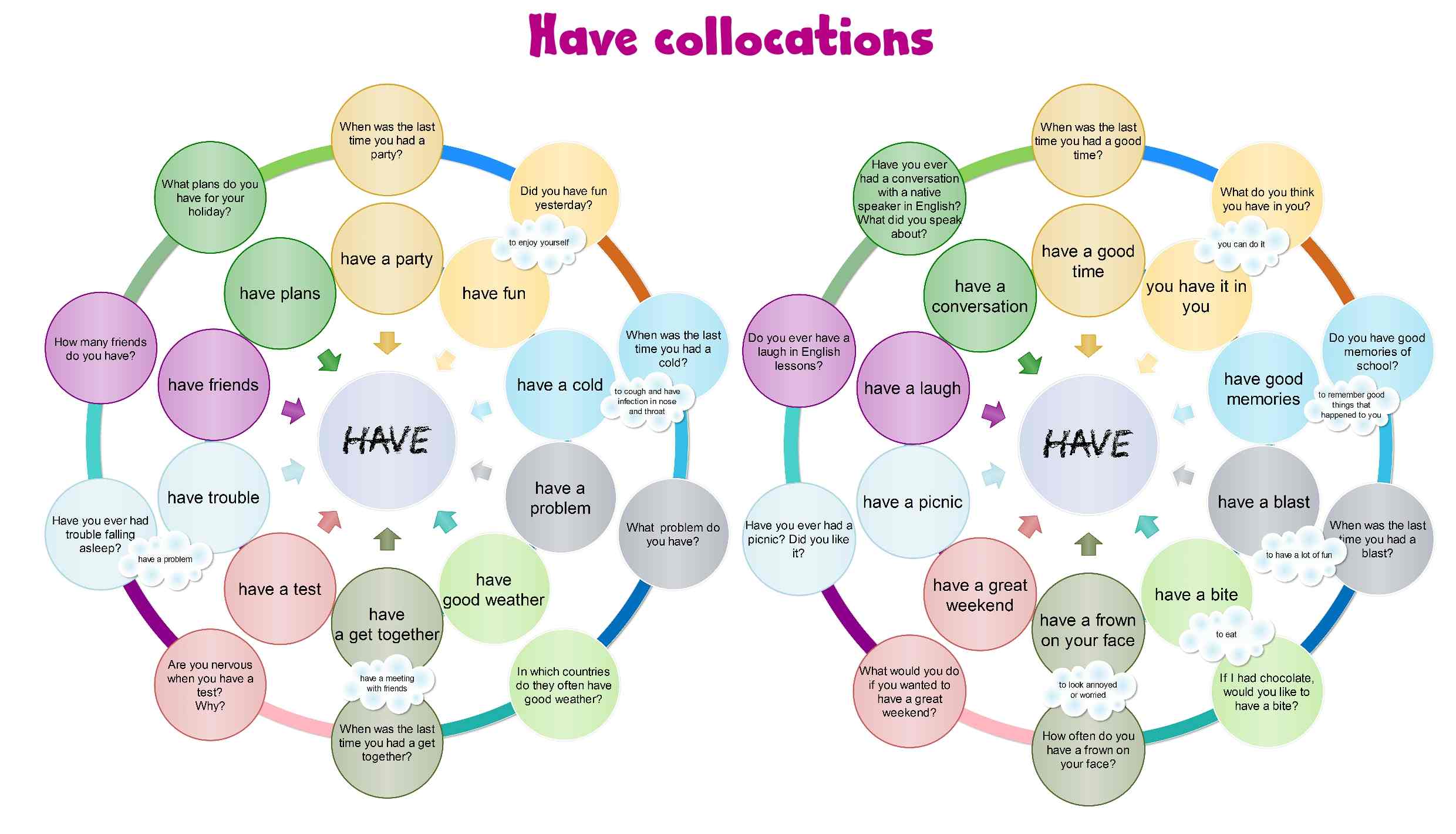
Then ask the students to work in pairs or small groups and to ask and answer the questions in the outer circles.
Have collocations – interactive quizzes
Both of the following games are created in HTML5, so they will play on all mobile devices.
The first game is called Quiz Goose Science, and your task is to click on the dice in the upper right hand corner. When you do, your avatar moves. If you finish your move on a question mark, you will be given a question. If you answer correctly, you will move ahead. If not, you will be moved backwards.
You can play against either the computer or other people.
To play on the full screen click the button:
Game – full screen
The second game is an interactive quiz. Your task is to answer all the questions as well as you can. If you pass the quiz you will be rewarded with a game.
To play on the full screen click the button:
Quiz – full screen
Links
I would like to thank Jason for his cooperation, and I hope we will publish many other posts together. In the meantime, you should check out the following videos by Fluency MC:
ADVERT:
[showmyadsa]
Most placement tests are for adults. There are few placement tests for young students. Thus, when a teacher tries to test his or her students’ proficiency in English using a standard placement test, the students quickly become discouraged because they don’t understand anything. Then the final results tell you nothing about the students´ knowledge.
This placement test is different. It contains only 40 multiple choice questions, and it is for students who are at level A1 of the CERF. If the students get more than 28 answers correct, their English is at level A1 CEFR. If they get over 36 answers correct they are well into A2 CEFR level.
The grammar tested here contains only the verbs BE, HAVE GOT and CAN, present simple and continuous tenses. About half of the items test students´ knowledge of vocabulary and phrases.
Placement test
There are two versions of the test. The first one is an interactive quiz, which you can try here:
ADVERT:
[showmyads]
To play the quiz on the full screen click the button below:
Or you can try the paper version of the test here.
I hope the test will help you know your students better and choose the right level for each of them.
Other Placement tests
This placement test is for students 9-13 years old. If you are looking for a placement test for younger students, you can try the one that is here.
If you are looking for a placement test for adults, try this one.
You can try a placement test by Saint George Institute.
Questions with the verbs WAS and WERE are among the most common in English. Therefore it is vital for students to learn these questions well. They have to be able to form them, understand them and answer them.
To help you teach these types of questions, I have included the following activities in this post: an infographic explaining the grammar, a worksheet, a motivational song, a memory quiz and an online quiz. I hope you will find these useful and that your students will master questions with the verbs WAS and WERE.
Basic grammar rules – infographic
Display the following infographic to your students and explain that questions with WAS and WERE usually start with these words. Elicit that you can add a WH word in front of them.
ADVERT:
[showmyads]
Basic grammar rules – worksheet
I try to teach the grammar using a topic that the students are interested in. This time I have chosen the topic Selfies.
Start the lesson with the following song and ask the students to complete the lyrics in the first exercise in the worksheet.
Then play the video for the students and ask them to check their answers.
In the second activity, they should work in pairs and discuss the questions about selfies. If you happen to have a group whose English is not very good, have the students ask you the questions. That way you can demonstrate the way they should answer, and at the same time you can clear up the meaning of the questions.
Now ask the students to put the worksheets away and play the following video:
When the video finishes, ask your students to answer the questions as well as they can. Ask them to answer in full. Once they finish this task, tell them to check their answers and count 1 point for each correct YES or NO and 2 points if they gave a full answer (like, Yes, she was.)
Find out the winner and congratulate them.
Play the video again and ask the students to write their own questions for the pictures.
Ask them to work in pairs and to ask and answer their own questions.
In the last exercise, students work in pairs and give true answers to the questions.
Basic grammar rules – online quiz
The following online quiz contains a lot of different tasks which the students can do either as homework or at school. The quiz is in HTML5 and it will play on all digital devices.
Basic grammar rules – links
There are some great activities for learning and practising WAS and WERE at the British Council site.
I like teaching prepositions of place. I can use the Cuisenaire rods, and my students can be creative in many ways and use English a lot.
Here I would like to share the activities I use to teach prepositions of place. In this post you can find the following activities: a mind map, an infographic, a worksheet and online exercises.
Prepositions of place – infographic
First, I introduce the prepositions of place using the following infographic. If you have an interactive whiteboard in your English class, you can display it there, or you can print it and hand it out to everyone in the class.
ADVERT:
[showmyads]
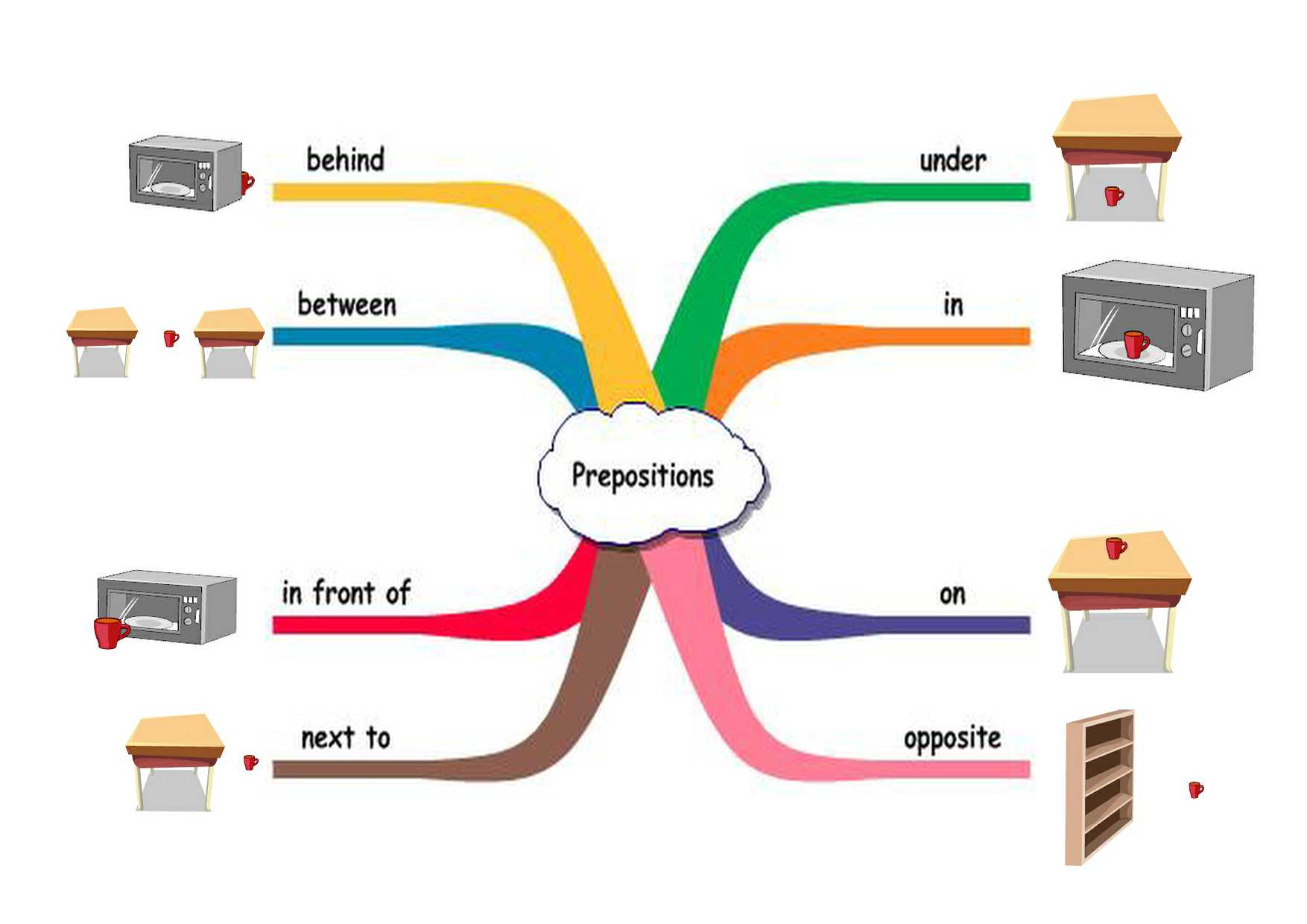
Then display the following mind map and elicit the prepositions.
Prepositions of place – worksheet
Hand out the following worksheet to your students. There are four pages and it is best to print out two pages on one sheet.
Prepositions of place worksheet
First you need to practise the names of pieces of furniture with your English class. You can find a furniture vocabulary post here.
Ask your students to solve the crossword and word search and then check their answers.
The second page concentrates on the prepositions. Ask your English class to figure out the names of the cats using the clues on the right.
In the task that follows, students should complete the sentences using the correct prepositions.
On the third page there is another infographic to introduce the meanings of the prepositions of place.
If you have a monolingual class and you speak their mother tongue, you could ask them to translate the sentences.
In the last task on page four, students have to place the pieces of furniture in the room. Then they have to describe their room to their partner and the listener has to draw the room.
Prepositions of place – Cuisenaire rods
My English classes love this activity. I bring the Cuisenaire rods and I give each pair of students a set. First, I tell them that they have 3 minutes to play with the rods.
After the 3 minutes I ask them to stop playing and put all the rods in the box. Then I dictate sentences like: Put the red rod on the table. Put the green rod under the red rod. Put the white rod next to the red rod.
I dictate 5 sentences and then we check the resulting shape.
In the next phase students work in pairs. One of them dictates and the other puts the rods on the table. After a while they swap their roles.
Prepositions of place – online quiz
You can either ask your English class to use the following online quiz at home or you can do it at school if you have enough computers.
As the quiz is in HTML5 and should play on every mobile device, you could even ask your English class to do the quiz on their mobile phones.
In the quiz there are several slides with questions. If the students pass the quizzes, they can play a game.
Prepositions of place – full screen
Prepositions of place – links
There are some great activities for learning and practising prepositions of place at the British Council site.
I always loved the word formation part of the FCE test. This was the part of the test where I always scored really high. However, some of my students don’t. So I sat down and tried to find out why I have been so successful in this part of the test.
And the result? I believe that I do well on these tests because I know the other forms of words. I take the key word and then learn all of its other forms, and when I meet the word in a test I am able to remember the correct form.
In this post I am going to give you a chance to do the same. I selected 10 words that regularly appear in the word formation test for B2 level, and I listed all the forms and example sentences. What should you do? Try to memorise all the forms from the infographic and then go through the online quizzes.
Word formation – infographic
Study the following infographic and try to remember all the forms. Do not forget to notice the differences in meaning.
ADVERT:
[showmyads]
Do not spend too much time just learning the forms. It is best to use them in context, so I believe it is time to move to the online quizzes.
Word formation – online quizzes
The first online quiz is in HTML5 so it will play on all devices. Your task is to choose the correct form of the words, and if you pass the quiz you will be given a chance to play a game as a reward.
Word formation quiz – full screen
The second game is called En Garde and it will only play on your desktop as it is made in flash. Your task is to choose the correct answer and then stop the circle as close to the centre as possible. Will you win?
Word formation quiz – full screen
Word formation – links
You can find more interesting exercises at the British Council site.
For an unknown reason many elementary textbooks teach HAVE GOT at the very beginning. Students find it difficult and they get confused. Moreover, they get even more fed up when they learn that the Americans do not use this form.
But I have to teach the grammar, so there is no use crying over spilt milk. To be honest, I was not very successful the last time I taught this grammar, and that is why I decided to create some new materials.
In this post you will find a song, an infographic, a worksheet with communicative activities, and an interactive online quiz.
Have got – song
Start the lesson with the following song. Ask the students to listen and complete the lyrics. Check their answers and ask the students to listen and sing along. In this way they will practise their pronunciation and grammar at the same time.
ADVERT:
[showmyads]
Have got – infographic
Now draw the students’ attention to the following infographic. Explain the form of the verb have got. This may be the right time to drill the form.
Once you have explained the grammar, it is time to practise it using the following worksheet. Download it and print it out.
Have got communicative worksheet
Ask the students to work in pairs. They must not show their pictures to their partners.
In the first exercise they look at their picture and write what they have in the bag.
In the second exercise they write questions asking whether their partner has the same things in their bag . When the students finish writing their questions, they work in pairs and ask and answer in pairs.
In the third exercise, the students look at their bags. Then they look at the objects on the right. They ask their partner whether Jane or David has these things in their bags. They tick or cross out the objects in their pictures.
Have got – online quiz
The following quiz can be taken at school or you canask your students to do it at home.
In the first part, the students should write correct sentences about the pictures using HAVE GOT. If they produce enough correct sentences, they will be able to play the game called Angry Farmer.
In the second part of the quiz they should first match the pictures and the words and then write them. In the last part of the quiz they have to write the correct answers. Again, if the students pass the quiz they will be rewarded with a game. This time they should write the words they see in the picture (of course, in English).
ADVERT:
[showmyadsa]


